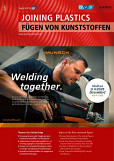Laser Transmission Welding With Intensity Distributions Adjusted to the Materials and the Components
Authors: M. Sc. Thomas Bussek, Dr.-Ing. Maximilian Brosda Flockenhaus, M. Sc. Jacqueline Dahlmanns, Dr.-Ing. Alexander Olowinsky, M. Sc. Stefan Behrens, Dr.-Ing. Annika Bonhoff, Prof. Dr. rer. nat. Carlo Holly
DOI: https://doi.org/10.53192/JP202503190
The utilisation of classic Gaussian or tophat intensity distributions in the process of laser transmission welding frequently leads to inadequate processing results particularly in the case of joining members with extreme scattering. The use of intensity distributions adjusted to the materials and the workpieces promises to raise the quality of the welds with a simultaneous increase in productivity. In order to determine such intensity distributions with a high number of degrees of freedom, the inverse heat conduction problem is solved for various material configurations taking account of the scattering in the transparent joining member. The established intensity distributions can be implemented and validated using a test setup with an integrated LCoS-SLM. In comparison with welds produced using classic Gaussian and tophat intensity distributions, the welds produced in this way exhibit fewer defects, more homogeneous welding profiles and increased fracture forces.
An active subscription enables you to download articles or entire issues as PDF-files. If you already are a subscriber, please login. More information about the subscription








